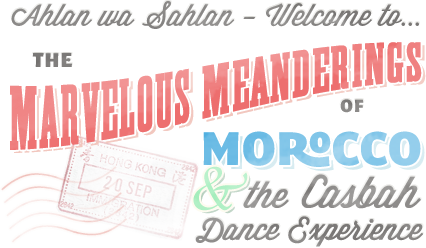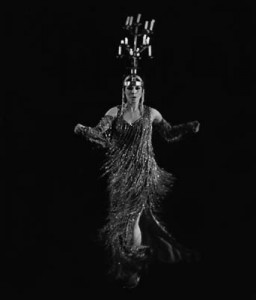New York – the Western Mecca for Middle Eastern dance. Dance mavens have their pick of any number of excellent “Big Apple” studios specializing in Oriental dance, but selecting a studio can be a difficult task in a market area filled with competent, talented instructors promoting their most valuable commodity: their talent. It is a matter of the serious student finding the right “fit” of personality, proficiency and environment. My personal search for this proper fit ended at Morocco’s studio in Manhattan.
Morocco is a veteran artist and instructor with over 42 years in the business of oriental dance. Those readers who have had the opportunity to study with her must respect both her candor, skill and immense knowledge of our craft. Morocco’s Chelsea (a neighborhood area of greater Manhattan) studio is a reflection of her personal excellence: the facility is well-appointed, clean spacious and air-conditioned – a necessity for New York summers! The Chelsea location is a bustling, safe neighborhood environment bordering Greenwich Village and Soho and mere blocks away from dynamite shopping in Manhattan’s garment district. To assist visiting students, Morocco provides comprehensive local information in advance for necessary items such as reasonable lodging convenient to the studio (decent hotels are plentiful) and cost-effective (cheap!) places to eat. Another plus about Morocco’s location is accessibility to public transportation and parking: recommended hotels are a brisk walk from the studio. Penn Station and the Port Authority are also convenient to Morocco’s location for students arriving by train, bus or local airports.
Morocco’s August 1993 master class commenced with a performance by Morocco and the Casbah Dance Experience. This particular show was designed to entertain and to give students a preview of coming attractions during the week of study. Featured in the Casbah’s wonderful repertoire of dances were Moroccan Tray, Shikhatt and Guedra, a Tunisian Women’s Dance, a Turkish “debke”-style dance, a Group Oriental Dance as well as excellent solo performances in Danse Oriental, Ghawazee, and a Sword Dance featuring Casbah soloists. Morocco cut loose with two high-energy solos: an Oriental Dance and an Egyptian Women’s Cane. The concert set the tempo for a week of hard work, valuable information and camaraderie.
When you study with Morocco, expect to busy – she is like the Eveready Bunny – Morocco just keeps on going (and so did we!) Forty-five minutes of technical warm-ups lead by Casbah’s lead male dancer and Morocco’s protegé, Tarik abd el Malik, started each day. This talented young man works thoroughly and competently in front of a class; Tarik is clear in his instruction, patient, & quickly corrects any problems which the class encounters. Following the warm-ups, Morocco took command, teaching 3 complete choreographies throughout our “work” week. Students also participated in more casual, interactive technique classes, involving special ethnic dance techniques; Moroccan Schickatt and Guedra, Saudi Arabian Women’s Dance, Tunisian folklore, and Ghawazee technique taught by Casbah instructor Djinni Hassanein. Considering the amount of material presented, most experienced dance students would expect “sit-outs”, but the participants in this week-long event worked enthusiastically throughout a five-hour class day (excluding an hour for lunch) of intense dance study.
It wasn’t all work, however: on Thursday, we got a chance to perform at the Cedars of Lebanon, a nice little club on 30th at Park Avenue. I was impressed by the casual, yet organized way in which Morocco managed our “student recital” and was really impressed at the array of talented people in our master class! Performances ran the gamut from “first-timer” to “old pros”, but all performers participating in this show executed wonderful dances! Our performance at the Cedars was one of the best, most entertaining shows in which I’ve been involved. The words “competition” or “upstage” just didn’t exist in any of our international vocabularies that evening, and we had a wonderful time dancing for each other (and the “civilians” in the audience!). We danced because we enjoy dancing; we danced because we enjoy the music; we danced because we enjoyed each other’s company and we were having a “Big Apple Hafla”, hosted by Morocco. It was pure joy to watch so many dancers savoring this opportunity to express themselves in a myriad of Oriental dance styles.
One of the most energizing features of Morocco’s weeklong seminar wasn’t just learning dance techniques or ethnic history – it was about meeting people, making new friends and creating a common, artistic bond between dancers from various backgrounds. Morocco attracted people from across the United States and Europe: people from Seattle, Washington to London, England and all over Germany, danced alongside each other creating a community of artists and performers. The concept of nationality ceased to exist within our class; we did, after all, share the common culture and language of Oriental music and dance. Language and national barriers fell before the unity we created out of our hard work, artistic respect for one another and dedication to our craft. As we discovered under Morocco’s leadership, our diverse group of dancers had more in common than merely attending the same lengthy dance seminar.
Morocco’s Master Class is a week well spent for any level of dancer interested in perfecting their skills. Morocco’s style of instruction does not stop at the physical execution of Middle-Eastern dance; instead she embraces a holistic teaching style which encourages the student to blend mind and soul into the medium of Danse Orientale technique. If art can be defined as the synthesis of technique, intellect and spirit, then Morocco is an excellent catalyst.

